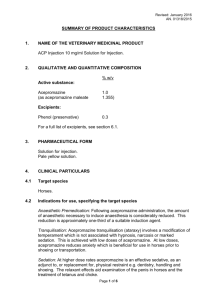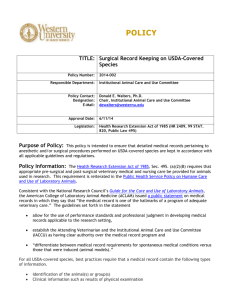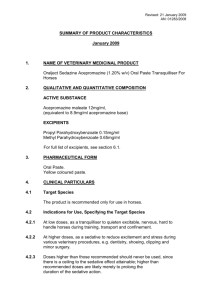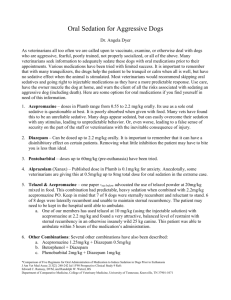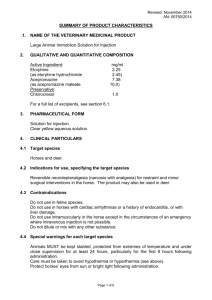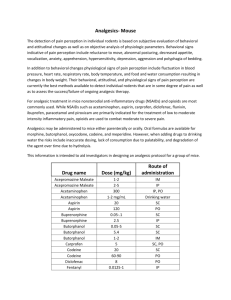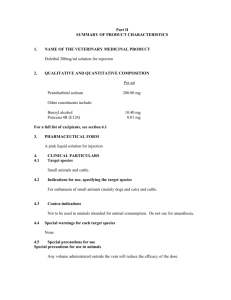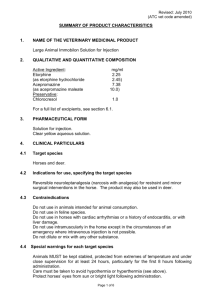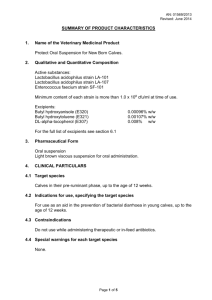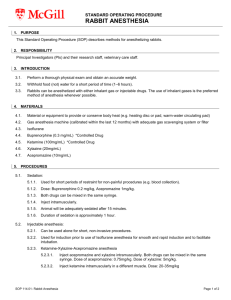ACP Tablets 10 mg - Veterinary Medicines Directorate
advertisement
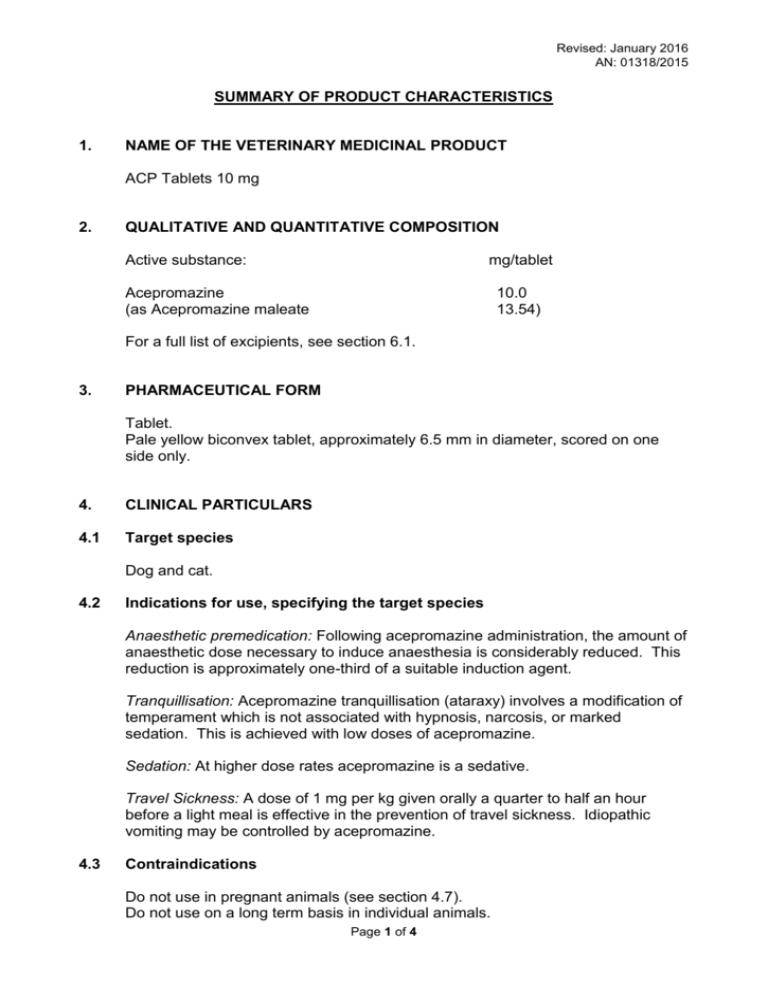
Revised: January 2016 AN: 01318/2015 SUMMARY OF PRODUCT CHARACTERISTICS 1. NAME OF THE VETERINARY MEDICINAL PRODUCT ACP Tablets 10 mg 2. QUALITATIVE AND QUANTITATIVE COMPOSITION Active substance: mg/tablet Acepromazine (as Acepromazine maleate 10.0 13.54) For a full list of excipients, see section 6.1. 3. PHARMACEUTICAL FORM Tablet. Pale yellow biconvex tablet, approximately 6.5 mm in diameter, scored on one side only. 4. CLINICAL PARTICULARS 4.1 Target species Dog and cat. 4.2 Indications for use, specifying the target species Anaesthetic premedication: Following acepromazine administration, the amount of anaesthetic dose necessary to induce anaesthesia is considerably reduced. This reduction is approximately one-third of a suitable induction agent. Tranquillisation: Acepromazine tranquillisation (ataraxy) involves a modification of temperament which is not associated with hypnosis, narcosis, or marked sedation. This is achieved with low doses of acepromazine. Sedation: At higher dose rates acepromazine is a sedative. Travel Sickness: A dose of 1 mg per kg given orally a quarter to half an hour before a light meal is effective in the prevention of travel sickness. Idiopathic vomiting may be controlled by acepromazine. 4.3 Contraindications Do not use in pregnant animals (see section 4.7). Do not use on a long term basis in individual animals. Page 1 of 4 Revised: January 2016 AN: 01318/2015 4.4 Special warnings for each target species There are no known special warnings. 4.5 Special precautions for use i) Special precautions for use in animals Acepromazine is hypotensive. Particular care should therefore be taken in hypovolaemic subjects; rehydration should precede acepromazine administration. In some dogs, particularly Boxers and other short-nosed breeds, spontaneous fainting or syncope may occur, due to sinoatrial block caused by excessive vagal tone, and an attack may be precipitated by acepromazine, so a low dose should be used. Where there is a history of this type of syncope, or if it is suspected because of excessive sinus arrhythmia, it may be advantageous to control the dysrhythmia with atropine given just before the acepromazine. Large breeds: it has been noted that large breeds of dog are particularly sensitive to acepromazine and the minimum dose possible should be used in these breeds. ii) Special precautions to be taken by the person administering the veterinary medicinal product to animals In the event of accidental ingestion seek medical advice, showing the package leaflet to the physician. Wash hands after use. 4.6 Adverse reactions (frequency and seriousness) See section 4.5 (i), Special precautions for use in animals. 4.7 Use during pregnancy, lactation or lay No formal studies on the safety of ACP Tablets in pregnant animals have been conducted (see section 4.3, Contraindications). 4.8 Interaction with other medicinal products and other forms of interaction Acepromazine is additive to the actions of other depressants and will potentiate general anaesthesia (see section 4.2, indications for use). 4.9 Amounts to be administered and administration route 0.25 - 3 mg per kg bodyweight by oral administration. Onset of effects will be observed after 10 - 15 minutes. Normally single doses of acepromazine are administered (see section 4.3, Contraindications). Page 2 of 4 Revised: January 2016 AN: 01318/2015 4.10 Overdose (symptoms, emergency procedures, antidotes), if necessary Transient dose-dependent hypotension may occur in cases of accidental overdose. Therapy should consist of discontinuing any other hypotensive treatment, supportive care such as intravenous infusion of warm isotonic saline to correct hypotension and close monitoring. Epinephrine (adrenaline) is contra-indicated in the treatment of acute hypotension produced by overdosage of acepromazine maleate, since further depression of systemic blood pressure can result. 4.11 Withdrawal period(s) Not applicable. 5. PHARMACOLOGICAL PROPERTIES Pharmacotherapeutic group: ATCvet code: 5.1. Antipsychotics QN05AA04 Pharmacodynamic properties Acepromazine is a phenothiazine. It is a central nervous system depressant with associated activity on the autonomic system. Phenothiazines have a central action due to inhibition of dopamine pathways, resulting in alteration of mood, reduction in fear and removal of learned or conditioned responses. Acepromazine possesses anti-emetic, anti-convulsant, hypothermic, hypotensive and anti-spasmodic properties, and shows a marked potentiating effect on barbiturate anaesthesia. 5.2 Pharmacokinetic particulars The length of action of acepromazine appears to be prolonged and to be dose dependent. 6. PHARMACEUTICAL PARTICULARS 6.1 List of excipients Lactose monohydrate Maize starch Pregelatinised starch Povidone K29-32 Magnesium stearate 6.2 Incompatibilities None known. Page 3 of 4 Revised: January 2016 AN: 01318/2015 6.3 Shelf life Shelf life of veterinary medicinal product as packaged for sale: 4 years. 6.4 Special precautions for storage Do not store above 25°C. Protect from light. 6.5 Nature and composition of immediate packaging White opaque polypropylene tub with a white opaque low density polyethylene lid, containing 500 tablets. 6.6 Special precautions for the disposal of unused veterinary medicinal product or waste materials derived from the use of such products Any unused veterinary medicinal product or waste material derived from such veterinary medicinal products should be disposed of in accordance with local requirements. 7. MARKETING AUTHORISATION HOLDER Elanco Europe Ltd Lilly House Priestly Road Basingstoke Hampshire RG24 9NL 8. MARKETING AUTHORISATION NUMBER Vm 00879/4011 9. DATE OF FIRST AUTHORISATION 24 July 1992 10. DATE OF REVISION OF THE TEXT January 2016 Approved: 13 January 2016 Page 4 of 4
